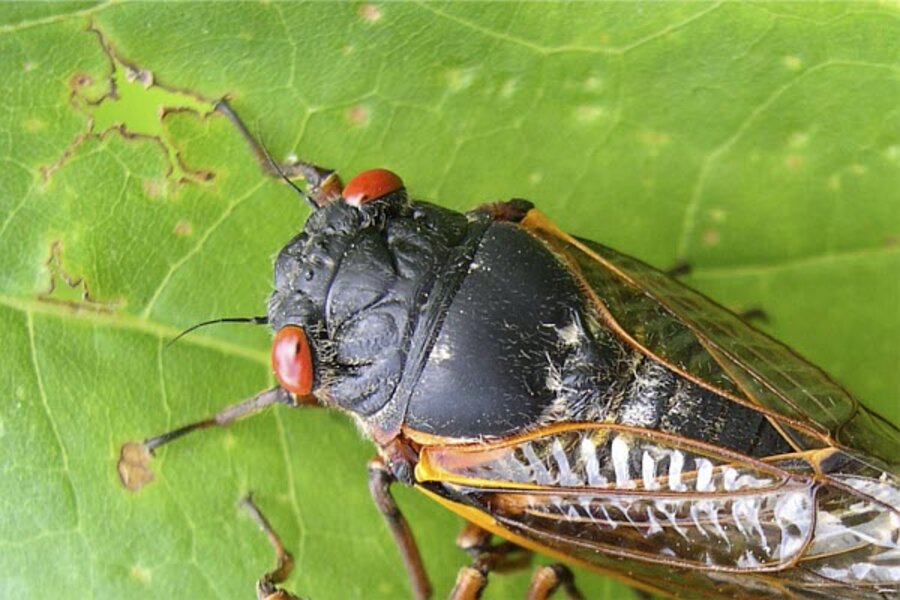Brood II: After 17 years, billions of eastern US cicadas rise again
Loading...
If you live on the East Coast and enjoy a walk in the woods or a tree-filled park, for the past 17 years you almost certainly have been walking over buried, juvenile cicadas, one of the most remarkable – and annoying – insects on the planet.
Now, it's their turn on stage. Between now and June in the eastern US, the insects are emerging from underground in a kind of Rolling Thunder Review from south to north as soils grow toasty enough to signal break-out time.
Over four to six weeks, males will sing to attract females. Pairs will hook up. Billions of tiny offspring will hatch from eggs the females deposit in trees. The tiny offspring will plummet to the ground and burrow back into the soil weeks after their parents – every winged, bulge-eyed one of them that hasn't been eaten by a bird, raccoon, or chipmunk – depart this vale of tears.
While most of the current sightings are east of the Appalachian Mountains, the bugs are appearing in the southern Plains as well, from Texas north to Nebraska, although these may be stragglers from a different brood. (Broods are identified by region, cycle length of 13 or 17 years, and years in which they reappear. The bugs appearing in the eastern US belong to Brood II.)
These “periodic” cicadas pose no serious threat to humans, although they can sting a bit if they mistake you for a tree, entomologists say.
Estimates put underground, periodic cicada populations at from tens of thousands to as many as 1.5 million individuals per acre. And they boast the longest life span of any insect, according to researchers Walter Koenig at Cornell University and Andrew Liebhold, with the US Forest Service's Northeastern Research Station in Morgantown, W. Va.
While the bugs have prompted people to alter wedding dates and forestall planting new, young trees until after the cicadas' festivities end, they play a number of roles in forest ecology, researchers say.
“There still are a lot of mysteries about how periodical cicadas interact in forest ecosystems,” says Dr. Liebhold, but one clear role seems be as a source of nutrients for forest soils.
Once the adults die and fall out of the trees and shrubs they occupied, they decompose. That tends to trap nutrients close to the roots, where the food is less vulnerable to leaching from the soil. This fertilizer feeds the trees and shrubs directly. It also feeds the next generation of cicadas indirectly because the nymphs that burrowed into the ground feed off fluids that move through small roots.
Researchers have found that the nymphs can have a pronounced effect on tree growth. Richard Karban, an ecologist at the University of California at Davis, has looked at tree rings as a measure of nymphs' effect on oak trees and found that the process can reduce tree growth by up to 30 percent.
When the bugs emerge from the soil during their brief appearances on the surface, they act as tiny soil aerators, adds Gene Kritsky, an entomologist at the College of Mt. Saint Joseph in Cincinnati. The tiny tunnels they burrow in the soil to escape can last for months, trapping precious rain when it falls during the summer.
The bugs also act as natural tree pruners, Dr. Kristky adds. The females lay their eggs under the bark of newly forming branches on trees. This can leave these branches vulnerable to high winds.
While such pruning can give a tree the appearance of being badly damaged, it also can spur future growth and higher yields, at least temporarily, in fruit trees.
“In subsequent years, the fruit set usually increases,” he says. “There was a paper published in the 1890s entitled 'Out of Evil Cometh Good.' Cherry orchards were reporting a greater yield following the emergence of cicadas.”
The long lifetime among periodic cicadas also has an effect on bird populations in the area.
Drs. Koenig and Liebhold noted in a 2005 study how bird populations tended to increase just after a cicada eruption, but then fall back to more stable levels or even decline right up to the next appearance of the bugs. The intensity of these demographic effects on birds varied by species and on how far afield they travel. For a small number of the species studied, the bird population declined because the birds left to find areas where food was more plentiful. For the rest, however, the presence, then absence of cicadas for food affected everything from adult bird size to the size of clutches and the survival success of fledglings.
In January, the duo looked at the issue from the cicadas' point of view and surmised that the bugs' unusually long life cycle “may 'engineer' bird populations” in a way that prevents the birds from being able to anticipate the next emergence. In effect, the bugs evolved a life cycle that ensured that the number of winged predators at the time the bugs emerged would be at a minimum.
These days, the bugs also have become another of nature's barometers of a warming climate, Kritsky adds. He's been modeling the interaction between the bugs' emergence and temperatures over the past two cycles, a project that requires people in the field to send him reports on when they first see the nymphs emerge and to tap historical records of past emergences.
The project aims to develop 10-day forecasts for periodic cicada emergence as a way to help arborists or orchard owners to avoid planting young trees until after cicadas have laid eggs.
In the process, Kristky has built a historical record of cicada emergence.
“Prior to 1950, they were emerging about the 28th or 29th of May” in the Cincinnati area, he says. “Since 1950, they're emerging about seven to 10 days earlier, on average.”





